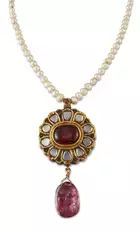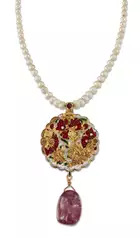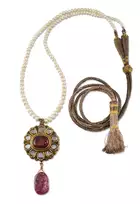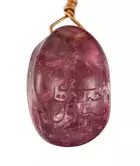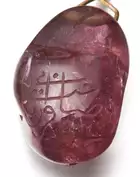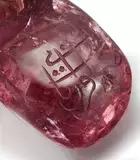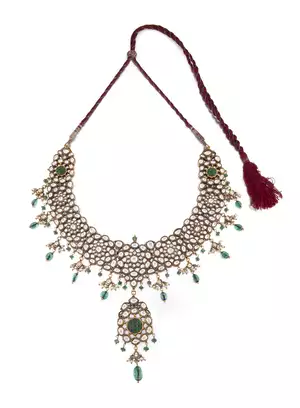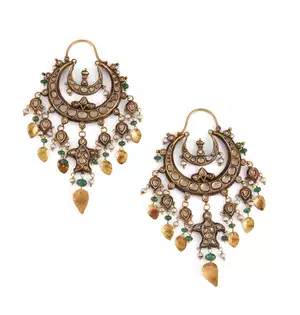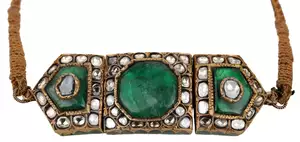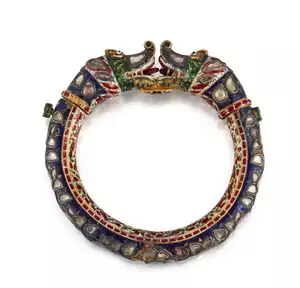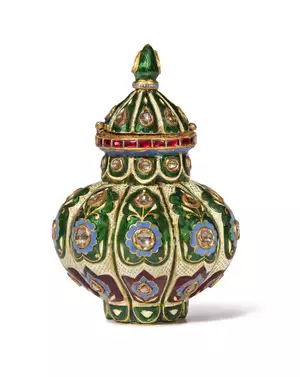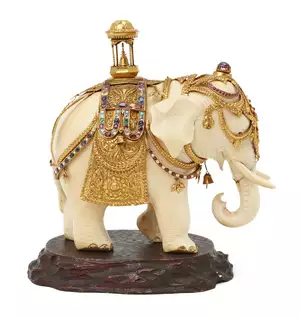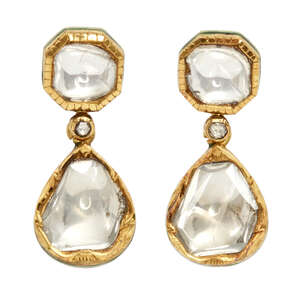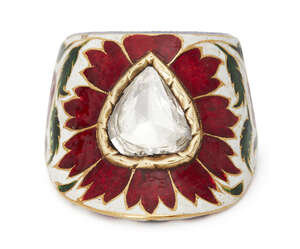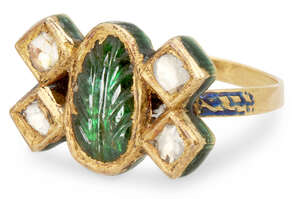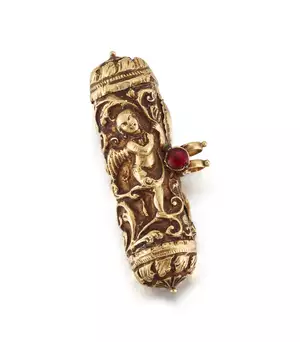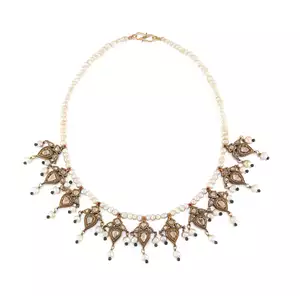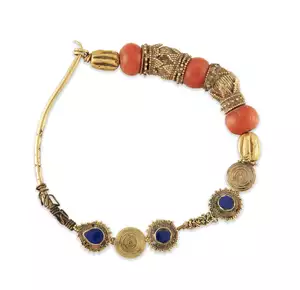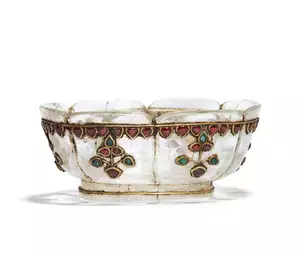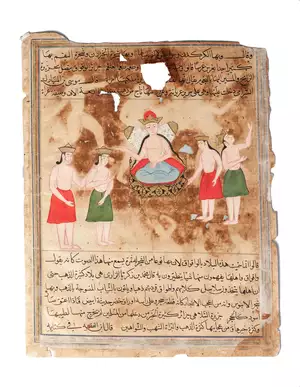Friday 1 April 2022
An important imperial Mughal spinel, inscribed with the title of Shah Jahan and dated...
View MoreLot 126
Description
An important imperial Mughal spinel, inscribed with the title of Shah Jahan and dated 1[0]39AH (1629-30AD), polished and drilled for suspension, hung on gold wire from a 17th century diamond- and spinel-set gold pendant in the form of a flower head, enameled to reverse with a red poppy flower on a white ground, on a string of natural pearls with silver metal thread attachment, spinel approx. 26 carats, pendant 3.7cm. high x 3cm. diam., overall height with spinel 6.6cm., weight 37 grams
Provenance: Private UK Collection, Raja Wazir Singh of Faridkot (1828-1874), and thence by descent
Inscription: "Second Lord of the Auspicious Conjunction 1[0]39
There is a small pendant in the Al Sabah Collection with enamel work on the reverse which seems close to the enamel on the pendant supporting the spinel, particularly in the way the flowers on the sides turn inwards and the design of the plant stem (Treasury of the World, Keene and Kaoukji 2001, p. 67, no. 6.15, LNS 142J).
Imperial Mughal Spinels essay by M.Spink
Spinels, also known as balas rubies, came from Badakhshan in northern Afghanistan. The Mughal rulers of India particularly valued the gem, with surviving examples engraved with the names of emperors from Akbar (r.1556-1605) to Farrukh Siyar (r. 1713-1719). Spinels are mentioned in contemporary literature, including the memoirs of the Mughal emperor Jahangir (r. 1605-1627). They also appear in miniature paintings, laid on trays of gems, or mounted in jewels. A folio in the St Petersburg Album depicts Jahangir in circa 1625-30 holding a sarpech which is set with a single large spinel.
Many spinels bear the name of more than one Mughal emperor, indicating that a gem remained in the treasury for more than one reign. Some were in effect imperial heirlooms: Jahangir recorded a spinel given to Akbar by his mother Hamida Banu Begum (wife of the emperor Humayun) on the occasion of Jahangirs birth. It later passed in turn to Jahangir and to Shah Jahan. Jahangir specifically mentioned another spinel, inscribed with the name of Ulugh Beg (r. 1447-9), a Timurid ruler, which was presented to him by Shah Abbas of Iran (r. 1587-1629), noting that as it had his ancestors names on it, he regarded the gift as a good omen.
Spinels inscribed during the reign of Shah Jahan (r. 1628-1658) bear one of two phrases. Some bear his name, written as Shah Jahan son of Jahangir Shah, sometimes but not always with a date and a regnal year. Others, including the present spinel, bear his cipher Second Lord of the Auspicious Conjunction, again with or without the date and regnal year. This is a reference to his ancestor Timur (r.1370-1405) who styled himself Lord of the Auspicious Conjunction. The Mughal emperors emphasized their descent from Timur to strengthen their legitimacy to the Mughal throne. However, none bear both of these phrases on the same stone. There is no single format for either type of inscription. The arrangement of the letters forming these two phrases varies, as does the positioning of the date and regnal year (if present). Similarly, the dots of the letter pointing may vary in location or not be present at all.
Inscribed Mughal spinels survive in a number of important collections, including the British Royal Collection, the Al Thani Collection and the Al-Sabah Collection. Spinels from the Mughal treasury, looted by the Iranian ruler Nadir Shah (r. 1736-47) when he sacked Delhi in 1739, are still to be found today in Iran in the bank vaults holding some of the treasure taken from India.
Many thanks to Michael Spink for his assistance in cataloguing this lot and for writing the accompanying essay
Bibliography:
Content 2016
Derek Content, Ruby, Sapphire & Spinel: An Archaeological, Textual and Cultural Study, Belgium: Brepols, 2016.
Jaffer 2019
Amin Jaffer (ed.), Beyond Extravagance. A Royal Collection of Gems and Jewels, (2nd edition): New York: Assouline, 2019.
Jahangir 1999
Jahangir, The Jahangirnama. Memoirs of Jahangir, Emperor of India, trans. Wheeler Thackston, Washington and Oxford: Freer Gallery of Art, Arthur M. Sackler Gallery, Oxford University Press, 1999.
Keene and Kaoukji 2001
M. Keene, and S. Kaoukji, Treasury of the World: Jewelled Arts of India in the Age of the Mughals. The al-Sabah Collection, Kuwait National Museum, London: Thames and Hudson, 2001.
Lightbown 1992
Ronald W. Lightbown, Mediaeval European Jewellery, London: Victoria and Albert Museum, 1992.
Meen and Tushingham 1969
V.B. Meen and A.D. Tushingham, Crown Jewels of Iran, Toronto: University of Toronto Press, 1969
Melikian-Chirvani 2001
A.S. Melikian-Chirvani, The Red Stones of Light in Iranian Culture. I. Spinels, Bulletin of the Asia Institute New Series, volume 15, 2001, pp. 77-110.
Moura Carvalho 2010
Pedro Moura Carvalho, Gems and Jewels of Mughal India, Nasser D. Khalili Collection of Islamic Art, XVIII, London: Nour Foundation with Azimuth Editions, 2010.
Spink and Ogden 2013
Michael Spink and Jack Ogden, The Art of Adornment. Jewellery of the Islamic Lands, The Nasser D. Khalili Collection of Islamic Art, London: Nour Foundation with Azimuth Editions, XVII, 2013.
Stronge 1996
S. Stronge, The myth of the Timur ruby, Jewellery Studies, vol. 7, 1996, pp. 5-12.
Von Habsburg 1996
Francesca von Habsburg (project conception), The St. Petersburg Muraqqa. Album of Indian and Persian Miniatures from the 16th Through the 18th Century and Specimens of Persian Calligraphy by Imad al-Hasani, Lugarno and Milan: ARCH Foundation and Leonardo Arte, 1996
Raja Wazir Singh succeeded in 1849 his father Raja Pahar Singh to the gaddi of Faridkot. A devout Sikh, Wazir Singh had received the rites of initiation at Gurdwara Sri Hazur Sahib, Nanded, sacred to Guru Gobind Singh. He founded new villages and introduced several reforms in the land revenue system. He also introduced a system of written plaints and himself held court. He placed his services at the disposal of the British government for the suppression of the 1857 rising and was rewarded with the title of Brar Bans Raja Sahib Bahadur and a salute of eleven guns. Raja Wazir Singh died at Kurukshetra on 21 April 1874 after a reign of 25 years and was succeeded by his son, Bikram Singh.
Fees & VAT
Buyer's Premium
The buyer shall pay the hammer price together with a premium thereon of 26% up to £20,000 (31.2% inclusive of VAT), 25% from £20,001 - £500,000 (30% inclusive of VAT), 20% from £500,001 thereafter (24% inclusive of VAT). The premium price is subject to VAT at the standard rate.
VAT
VAT is not charged on the hammer price unless it is stated that there is 'VAT applicable on the hammer price at the end of the description. Buyer's premium is subject to VAT.(ARR) - ARTIST'S RESALE RIGHT
Qualifying living artists and the descendants of artists deceased within the last 70 years are entitled to receive a re-sale royalty each time their work is bought through an auction house or art market professional.
It applies to lots with hammer value over £1,000 as follows:
0 to £50,000 - 4%
£50,000.01 to £200,000 - 3%
£200,000.01 to £350,000 - 1%
£350,000.01 to £500,000 - 0.5%
Exceeding £500,000 - 0.25%
ARR is capped at £12,500
Please note ARR is calculated in euros. Auctioneers will apply current exchange rates.
Export of goods
Buyers intending to export goods should ascertain whether an export licence is required before bidding. Export licences are issued by Arts Council England and application forms can be obtained from its Export Licensing Unit. Details can be found on the ACE website www.artscouncil.org.uk or by phoning ACE on 020 7973 5188. The need for import licences varies from country to country and you should acquaint yourself with all relevant local requirements and provisions before bidding. The refusal of any such licences shall not permit the cancelling of any sale nor allow any delay in making full payment for the lot.
Own a similar item?
Request a ValuationReceive alerts about similar lots
Get StartedContinue Browsing
LOT 127
A sapphire-set enamelled gold necklace, North India, 19th century, comprising white...
Estimate: £10000 - £15000
LOT 128
A pair of gold sapphire-set pendant earrings, Punjab, North India, first half 19th...
Estimate: £4000 - £6000
LOT 129
A diamond- and emerald- set gold bazuband, Jaipur, India, mid-19th century, in three...
Estimate: £20000 - £30000
LOT 130
A makara head enamelled gold bangle set with table-cut sapphires, Jaipur, India, circa...
Estimate: £8000 - £10000
LOT 131
A diamond- and ruby-set enamelled lidded vessel, Jaipur, North India, 1800-1850, of...
Estimate: £6000 - £8000
LOT 132
A Mughal gem-set and enamelled gold archer's ring set with turquoise, North India, 19th...
Estimate: £3000 - £5000
LOT 133
A gem-set, gilt-silver mounted ivory elephant, Ceylon (Sri Lanka), circa 1910, on an oval...
Estimate: £3000 - £5000
LOT 134
A pair of diamond-set drop gold earrings, India, 20th century, to each the octagonal stud...
Estimate: £5000 - £7000
LOT 135
An impressive diamond-set enamelled gold archer's ring, Jaipur, India, late 19th century,...
Estimate: £12000 - £15000
LOT 136
A diamond and emerald-set gold ring, India, 20th century, the central oval emerald with a...
Estimate: £400 - £600
LOT 137
A gold relief decorated taviz pendant, probably Deccan or Western India, late 16th-early...
Estimate: £1500 - £2500
LOT 138
A Mughal diamond and natural pearl necklace, India, early 20th century, formed of a...
Estimate: £7000 - £9000
LOT 139
A rectangular cut emerald inscribed in Persian with the Ayat al-Kursi (Throne verse),...
Estimate: £1800 - £2000
LOT 140
A gold lapis and coral nose ring, South India, late 19th-early 20th century, of large...
Estimate: £600 - £800
LOT 141
A gem-set lobed rock crystal bowl, India, 20th century, of deep form on a short foot,...
Estimate: £600 - £800
LOT 142
The inhabitants of island of Al-Ramini and the Enthronement of Queen Waqwaq, Bijapur,...
Estimate: £200 - £400
 Newsletter Signup
Newsletter Signup
 Keyword Alerts
Keyword Alerts
Would you like to receive personalised keyword alerts when new catalogues go live. If so, please indicate these below
Set a password to save your keyword alerts
Passwords are a minimum of 7 characters and must include an upper case letter, a lower case letter, a number and a special character (e.g., !@#$%^&*).


